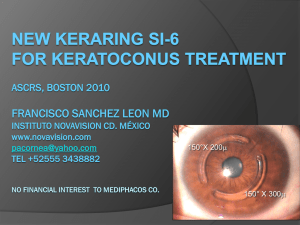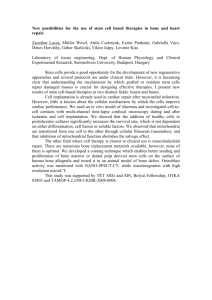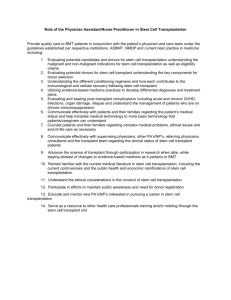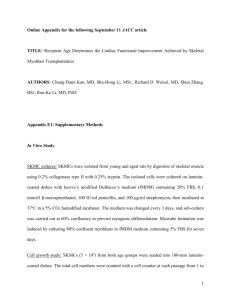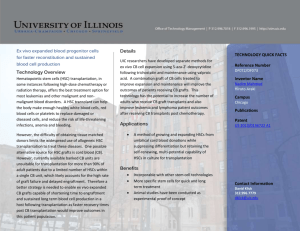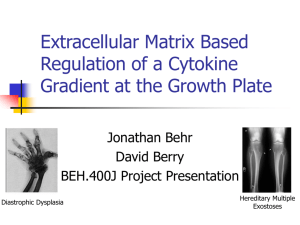Tissue Engineering for Cardiovascular Diseases
advertisement
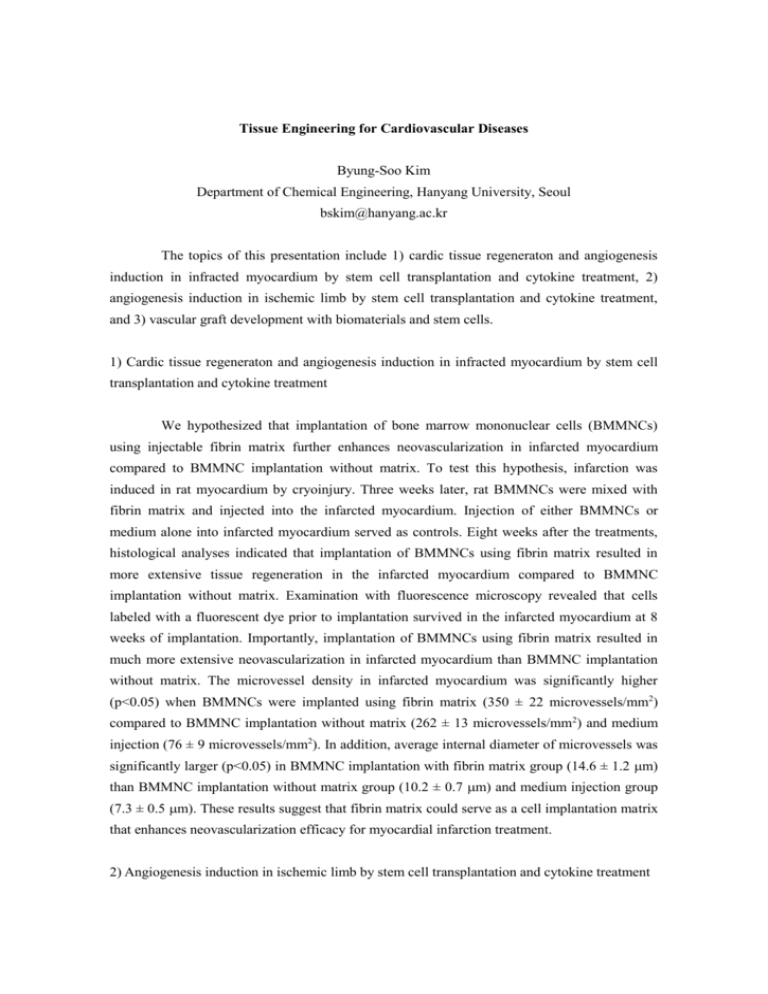
Tissue Engineering for Cardiovascular Diseases Byung-Soo Kim Department of Chemical Engineering, Hanyang University, Seoul bskim@hanyang.ac.kr The topics of this presentation include 1) cardic tissue regeneraton and angiogenesis induction in infracted myocardium by stem cell transplantation and cytokine treatment, 2) angiogenesis induction in ischemic limb by stem cell transplantation and cytokine treatment, and 3) vascular graft development with biomaterials and stem cells. 1) Cardic tissue regeneraton and angiogenesis induction in infracted myocardium by stem cell transplantation and cytokine treatment We hypothesized that implantation of bone marrow mononuclear cells (BMMNCs) using injectable fibrin matrix further enhances neovascularization in infarcted myocardium compared to BMMNC implantation without matrix. To test this hypothesis, infarction was induced in rat myocardium by cryoinjury. Three weeks later, rat BMMNCs were mixed with fibrin matrix and injected into the infarcted myocardium. Injection of either BMMNCs or medium alone into infarcted myocardium served as controls. Eight weeks after the treatments, histological analyses indicated that implantation of BMMNCs using fibrin matrix resulted in more extensive tissue regeneration in the infarcted myocardium compared to BMMNC implantation without matrix. Examination with fluorescence microscopy revealed that cells labeled with a fluorescent dye prior to implantation survived in the infarcted myocardium at 8 weeks of implantation. Importantly, implantation of BMMNCs using fibrin matrix resulted in much more extensive neovascularization in infarcted myocardium than BMMNC implantation without matrix. The microvessel density in infarcted myocardium was significantly higher (p<0.05) when BMMNCs were implanted using fibrin matrix (350 ± 22 microvessels/mm2) compared to BMMNC implantation without matrix (262 ± 13 microvessels/mm2) and medium injection (76 ± 9 microvessels/mm2). In addition, average internal diameter of microvessels was significantly larger (p<0.05) in BMMNC implantation with fibrin matrix group (14.6 ± 1.2 m) than BMMNC implantation without matrix group (10.2 ± 0.7 m) and medium injection group (7.3 ± 0.5 m). These results suggest that fibrin matrix could serve as a cell implantation matrix that enhances neovascularization efficacy for myocardial infarction treatment. 2) Angiogenesis induction in ischemic limb by stem cell transplantation and cytokine treatment We hypothesized that the combined therapy of bFGF sustained delivery and bone marrow stem cell transplantation further enhances angiogenesis in ischemic tissues compared to each separate therapy. To test this hypothesis, mouse limb ischemia was induced and treated with the combined therapy or each separate therapy. To develop an optimal bFGF delivery system, bFGF-loaded fibrin gels were prepared by adding various doses of thrombin to bFGF-fibrinogen solution with or without heparin. The release of bFGF from heparin-lacking fibrin gels was initially rapid, then reached equilibrium over a 6-day time period, respectively. In the presence of heparin, bFGF release significantly decreased. As the thrombin content in the fibrin gels increased, the bFGF release rate significantly decreased. Basic FGF released from fibrin gels stimulated human dermal fibroblast growth, indicating that bFGF released from fibrin gels was in a bioactive form. Basic FGF released from fibrin gels exhibited significantly higher extents of fibroblast growth than bFGF daily added in a free form into the culture medium, suggesting that bFGF released from fibrin gels is more stable than bFGF in a free form. Ischemia was induced in mouse hind limbs by the ligation of femoral arteries. Two weeks later, the mice were treated with no treatment, free bFGF daily injection, bFGF delivery system injection, stem cell transplantation, or bFGF delivery system injection/stem cell transplantation. Four weeks after the angiogenic treatments in the ischemic mice, histological examinations and microvessel density determination indicated that angiogenesis was stimulated by bFGF delivery system injection or stem cell transplantation. More extensive neovascularization occurred in bFGF delivery system injection group than free bFGF daily injection group. Compared to each bFGF delivery system injection or stem cell transplantation therapy, the combined therapy further enhances angiogenesis. The combined therapy of angiogenic protein delivery and stem cell transplantation could be a potentially efficacious therapy for limb ischemia. 3) vascular graft development with biomaterials and stem cells Cardiovascular diseases urge the development of a small-diameter vascular graft applicable for coronary or peripheral artery bypass grafting. Here we show that bone marrowderived cells (BMCs) have the potential to regenerate vascular tissues and improve patency in tissue-engineered small-diameter (internal diameter = 3 mm) vascular grafts. Canine BMCs were induced to differentiate in vitro into smooth muscle –actin/smooth muscle myosin heavy chain-positive cells and von Willebrand factor/CD31-positive cells by culturing BMCs in different types of media. The differentiated BMCs were seeded on decellularized canine carotid arteries and maintained in vitro for 1 week. The vascular grafts had the suture retention strength similar to that of the native canine carotid arteries. The vascular grafts seeded with BMCs remained patent for up to 8 weeks in the canine carotid artery interposition model, whereas nonseeded grafts occluded within 2 weeks. Within 8 weeks after implantation, the vascular grafts showed regeneration of the three elements of artery (endothelium, media, and adventitia). This is the first report of a small-diameter neovessel engineered with BMCs as a cell source.
